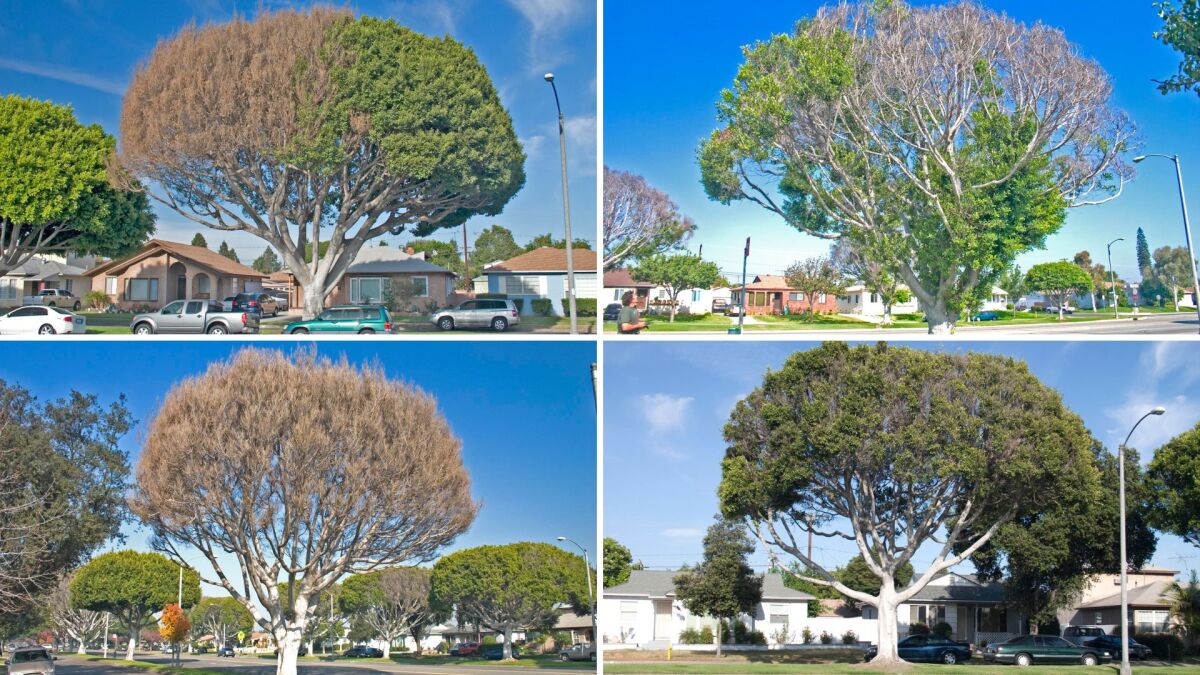Severe pruning — a.k.a. “coat racking” — is never good for ficus and other evergreen trees, but pruning during high heat is even worse.
Evergreen trees like the ficus that were heavily pruned outside Universal Studios last weekend where striking screen writers and actors have been walking picket lines, need a large canopy of leaves to stay healthy, especially during the summer.
Just like people, trees get stressed by high temperatures, and just like people, they need their own shade too, to protect the more vulnerable parts of their bark used to growing under their canopy of leaves, said Don Hodel, tree expert and retired horticultural landscape advisor to the UC Cooperative Extension office of Los Angeles County.
“Professional certified arborists definitely frown upon coat racking or hat racking, where you prune the tree so hard it looks like a hat rack,” Hodel said. “They might do it at the owner’s insistence but a reputable arborist will tell them this is bad for your tree and some will just refuse to do it at all.”
Demonstrators sounded the alarm on TikTok and Twitter about the loss of shade in 90-plus degree heat, causing a flurry of discussion about what’s been jokingly called “tree law” — as in the rules around trimming city-managed trees in the public right of way. NBCUniversal told the Times it annually prunes at this time of year with licensed arborists. The Los Angeles City Controller’s Office is investigating the issue.

WGA and SAG-AFTRA member Dee Thompson walks past recently trimmed trees as he carries a sign on a picket line outside Universal studios on Wednesday in Burbank, Calif.
(Chris Pizzello / Associated Press)
Heavy pruning is harmful because trees use their leaves as solar receptors for photosynthesis, Hodel said. The trees use the water at their roots, sunlight on their leaves and carbon dioxide to create the carbohydrates — sugars — they need to survive and the oxygen we need to breathe.
When that canopy of leaves is removed, Hodel said, trees must rely on stored sugars to survive, adding additional stress to the burden of living in super high heat.
That’s why trees really need their canopies during hot summer temperatures, said James Downer, a plant pathologist and horticulturist who teaches arboriculture at Cal Poly Pomona and just retired from the Ventura County UC Cooperative Extension office.
“Pruning those trees in this huge heat wave is unconscionable,” Downer said. “Everything depends on photosynthesis, so you cripple trees when you do this. This is the worst time to prune a tree, unless you really want to stunt its growth; then it’s a good time to do it because it will definitely have an impact.”
Like people, Hodel said, trees have parts of their anatomy that are used to being in shade. When that canopy is removed, he said, the shade bark is more vulnerable to sun damage, which creates wounds that make the tree more vulnerable to disease and invasive pests.
In the case of ficus, Hodel and Downer said, this is a very real concern, because the trees are highly susceptible to the fungal disease Botryosphaeria spp., also known as ficus canker disease or ficus branch dieback, a slow death that causes branches to have yellow leaves and eventually wither, branch by branch, killing the tree within a couple of years.
This pathogen is ubiquitous in Southern California, Downer said, and researchers suspect it’s spread by pruning.

Ficus in various stages of ficus canker disease, a.k.a ficus branch dieback, a fungal disease that slowly kills the trees.
(Donald R. Hodel)
“It hasn’t been proven but there’s lots of circumstantial evidence; you can see the pathogens spread right down the street after pruning operations,” Downer said. “It’s killing trees in Beverly Hills, Santa Monica, all over. Pathogens want wounds and pruning causes wounds, and pathogens also like stress, which happens during high heat, so pruning this time of year is the worst thing you can do if you want to avoid ficus canker disease.”
Ornamental trees like ficus don’t really need pruning at all to stay healthy, said Downer. “People just prune trees for their own needs — because they don’t like the shape, for instance, or the trash truck hits one of the branches.
Downer warned against relying on tree advice from “licensed” arborists, because the term licensed doesn’t certify anything in terms of tree knowledge. “When someone says they’re ‘licensed,’ that should send off red bells and whistles. It could mean anything, like a city business license, because there are no statewide credentials.”
Certified arborists have to pass an exam about tree culture and maintenance to get their credentials from the International Society of Arboriculture, and they’re required to do continuing education to maintain their credentials, he said. The organization provides a list of certified arborists by ZIP code.
If you must trim, Hodel said, evergreens like ficus should only be pruned in the late winter or early spring — February through April— just before they start growing new leaves. And you only want to remove a small percentage of the overall canopy, he said, to ensure the tree has enough leaves to stay healthy.
A ficus trimmed properly in the early spring shouldn’t need further pruning during the year, he said.
Deciduous trees that lose all their leaves in the fall, including fruit trees, should be pruned before they leaf out again, which is January through March in Southern California, Hodel said. Some fruit trees can be lightly pruned during the summer, to keep them from growing so tall you can’t reach the fruit, but again, you want to maintain as much canopy as possible.
When temperatures are soaring, the best thing for trees is to offer them a long deep soak every couple of weeks, Hodel said. He uses a drip system around his trees, that runs every 10 days or so for about an hour.
If you don’t have drip irrigation, just use a hose set at a very slow trickle and let it run somewhere between the tree trunk and the tree’s outer leaves, known as the drip line.
The goal is to send water deep into the ground, at least 12 inches deep. You can use a shovel to see how deeply the water is going into the ground, or you can invest in an inexpensive soil moisture meter with a 12-inch probe to gauge the depth of your watering.
Downer said he has little faith in moisture readers; it’s better to understand your soil, he said. Clay soils hold water longer than sandy soils, he said, but basically, “if you can stick a probe in the ground, the soil probably has moisture. If you can’t stick it n the ground, it’s probably really dry.” A safe bet is to deep water trees at least once a month during the hot months, he said.
Hodel also recommends adding a few inches of mulch under your trees to conserve moisture and keep the soil cool.
For all the latest Life Style News Click Here
For the latest news and updates, follow us on Google News.
